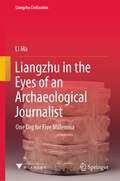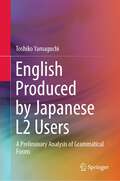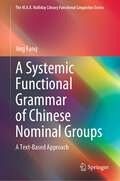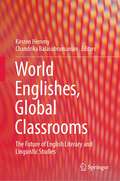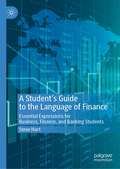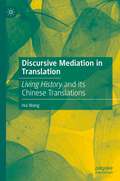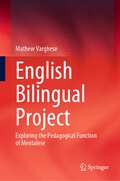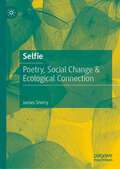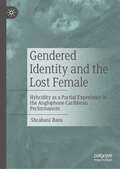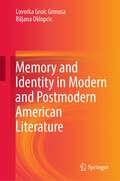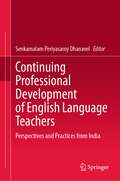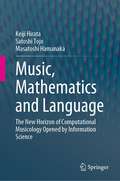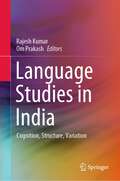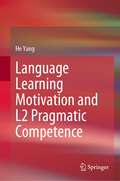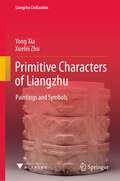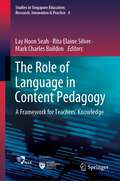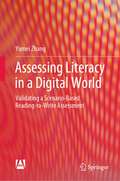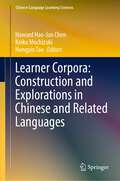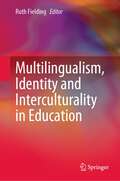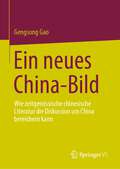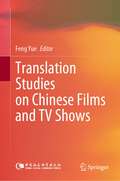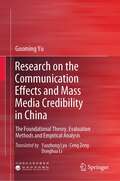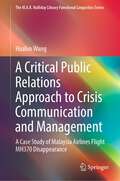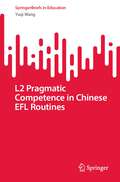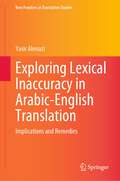- Table View
- List View
Liangzhu in the Eyes of an Archaeological Journalist: One Dig for Five Millennia (Liangzhu Civilization)
by Li MaThis book traces archaeological exploration and discoveries as early as 2012 and reveals Liangzhu culture by reviewing seven years of archaeological findings at the Liangzhu historical site, developments in archaeology history, the psychological journeys of archaeologists, as well as the collision of schools of thought. It also contains in-depth interviews with archaeological experts and other specialists, building a bridge between popular interest and academic interest, and showcases Liangzhu civilization and archaeology for professionals and the general public alike.
English Produced by Japanese L2 Users: A Preliminary Analysis of Grammatical Forms
by Toshiko YamaguchiThis book discusses eight grammatical items, with main focus on prepositions and plural nouns, to illustrate the structure of Japanese English or the English spoken by 32 Japanese nationals who are the L2 users of English. Adopting an inductive, theory-neutral, analysis of empirical data collected from recordings of presentational talks, the author demonstrates how standard and nonstandard grammatical forms are distributed, and categorizes these based largely on functional factors. The book describes grammatical forms as a fundamental aspect of linguistic study and adopts a corpus-driven approach to qualify structural features characterizing usage data. This formalization of language usage patterns also facilitates the development of ‘locally’ relevant norms and thus presents alternatives to the normative varieties traditionally adopted. It examines the effects of multicompetence and unpacks the grammar of Japanese English. The book is of interest to researchers, educators, and students concerned with issues related to World Englishes, English as a lingua franca, English language teaching, and multilingualism, this text is vital to studies in global English language use.
A Systemic Functional Grammar of Chinese Nominal Groups: A Text-Based Approach (The M.A.K. Halliday Library Functional Linguistics Series)
by Jing FangThis book describes the grammar of Chinese nominal groups for the purpose of text analysis, drawing upon Halliday’s systemic functional linguistics (SFL) model. Exploring the metafunctional grammatical resources in nominal groups, the book provides a new perspective on conducting text analysis by focusing on the metafunctions performed by various elements in the nominal group. The observations on nominal groups presented here are based on both a working corpus of 180 texts of various types and a large referential corpus of over 16 billion tokens. With clear descriptions of the terminology used, the book presents a case study at the end of each major chapter, which demonstrates how the grammatical resources discussed can be applied to the delicate analysis of authentic texts. This monograph is more than a grammar book, for it offers a new way to engage with a text microscopically and enables readers to approach and analyse a text by focusing on grammatical units below the clause level. The book provides an accessible and valuable resource for readers who are interested in SFL-based typological description, text analysis, translation studies between English and Chinese, English–Chinese comparative linguistic studies, and Chinese language teaching and learning.
World Englishes, Global Classrooms: The Future of English Literary and Linguistic Studies
by Kirsten Hemmy Chandrika BalasubramanianThis book provides a critical overview of contemporary world issues in Language and Literary Studies. It offers specific ideas as to how to move away from the traditional literary canon, on the one hand, and traditional native-speaker norms in English language teaching, on the other. It delivers a global perspective of both the growth and the challenges in ELT studies around the world. Following the introduction, the first section of the book contains chapters from international scholars on recognizing and diversifying Englishes in today’s language and translation classrooms. Specifically, the chapters focus on issues such as the cultural hegemony of a monolithic English, English and university pedagogy, English as a gatekeeper, and the role of a reconceived English education in promoting cross-cultural understanding. The second section focuses on the interaction of literature and culture, with specific chapters focusing on decolonizing the traditional literary canon, defining a global text, representing cultural interactions in literary texts, and emerging genres in contemporary English literature. Both sections of the book question the existing boundaries in a post-2020 world, specifically in a non-western world. It is an indispensable resource for scholars in cultural studies, linguistics, and literary studies.
A Student’s Guide to the Language of Finance: Essential Expressions for Business, Finance, and Banking Students
by Steve HartThis book focuses on improving reading comprehension by targeting the jargon, idiomatic language and academic expressions used in the business world. A Student’s Guide to the Language of Finance is a reference textbook designed to unlock the jargon of the business and finance world for international students, improving the reading comprehension and writing skill of English language learners by targeting the jargon, idiomatic language, and academic expressions employed in the business, finance, and banking fields. Covering terms not always captured in business dictionaries or workbooks, the resource also contains sections on spoken business English, key academic terms found in textbooks and journals and useful expressions to employ when writing an academic paper. It is specifically targeted at students whose first language is not English.
Discursive Mediation in Translation: Living History and its Chinese Translations
by Hui WangThis book explores the actual process of mediation operation in the translation process and the interaction between mediation and social structure. It defines mediation in translation in a parameterized manner, characterizing the linguistic properties of mediation for ease of mediation identification. On this basis, it puts forward an integrated systematic approach to map out mediation operation at the text level and discuss the interactive relationship between mediation and social structure, with a view to unveiling how the source text is altered for the purpose of power balance in the translation process. It is a key read for those interested in better understanding of how translators mediate in the translation process so as to maneuver a text to achieve a certain purpose, thereby increasing mediation efficiency and avoiding potential pitfalls in mediation operation. It will be of interest to students and scholars in translation studies, professional translators, as well as those working in language and culture, intercultural communication, and cultural studies.
English Bilingual Project: Exploring the Pedagogical Function of Mentalese
by Mathew VargheseToday, English is the global lingua franca and competent English communication skills should be one of the rights of all educated individuals irrespective of any socio-cultural limits. By introducing a new method, this book focuses on helping any learner to get sufficient communication skills in English as much as in the native language. This method helps one to avoid translating from mother tongue to English. And by using the method of thinking in English, one could acquire the required English bilingual skills naturally. The method is founded on the philosophical idea of mentalese—mind language as the base language of thinking available for humans for constructing thoughts. The proposed English Bilingual Project (EBP) helps one to transfer thoughts from a structureless mentalese to the grammatical structure of any language English/Japanese/Chinese. The method described in this book works in two ways: one it helps one to intuitively understand the working of mentalese; the other is by practicing think in English with the mentalese, one could generate the bilingual brain. The main procedure for transferring thoughts from the mentalese to English is through writing one’s thoughts. This helps one to think effectively in English like one’s own mother tongue. This method works as a prime requirement model for one to generate multilingual skills. The book resourced the idea of mentalese from the classical philosophy, reflects it with the modern generative theories, links it with the studies in neuro-linguistic studies on bilingualism and the bilingual brain.
Selfie: Poetry, Social Change & Ecological Connection
by James SherrySelfie: Poetry, Social Change & Ecological Connection presents the first general theory that links poetry in environmental thought to poetry as an environment. James Sherry accomplishes this task with a network model of connectivity that scales from the individual to social to environmental practices. Selfie demonstrates how parts of speech, metaphor, and syntax extend bidirectionally from the writer to the world and from the writer inward to identities that promote sustainable practices. Selfie shows how connections in the biosphere scale up from operating within the body, to social structures, to the networks that science has identified for all life. The book urges readers to construct plural identifications rather than essential claims of identity in support of environmental diversity.
Gendered Identity and the Lost Female: Hybridity as a Partial Experience in the Anglophone Caribbean Performances
by Shrabani BasuThis book offers an exploration of the postcolonial hybrid experience in anglophone Caribbean plays and performance from a feminist perspective.In a hitherto unattempted consideration of Caribbean theatre and performance, this study of gendered identities chronicles the postcolonial hybrid experience – and how it varies in the context of questions of sex, performance and social designation. In the process, it examines the diverse performances of the anglophone Caribbean. The work includes works by Caribbean anglophone playwrights like Derek Walcott, Mustapha Matura, Michael Gikes, Dennis Scott, Trevor Rhone, Earl Lovelace and Errol John with more recent works of Pat Cumper, Rawle Gibbons and Tony Hall. The study would also engage with Carnival, calypso and chutney music, while commenting on its evolving influences over the hybrid imagination.Each section covers the dominant socio-political thematics associated with the tradition and its effect on it, followed by an analysis of contemporaneously significant literary and cultural works – plays, carnival narrative and calypso and chutney lyrics as well as the experiences of performers. From Lovelace’s fictional Jestina to the real-life Drupatee, the book critically explores the marginalization of female performances while forming a hybrid identity.
Memory and Identity in Modern and Postmodern American Literature
by Lovorka Gruic Grmusa Biljana OklopcicThis book discusses how American literary modernism and postmodernism interconnect memory and identity and if, and how, the intertwining of memory and identity has been related to the dominant socio-cultural trends in the United States or the specific historical contexts in the world. The book’s opening chapter is the interrogation of the narrator’s memories of Jay Gatsby and his life in F. Scott Fitzgerald’s The Great Gatsby. The second chapter shows how in William Faulkner’s Light in August memory impacts the search for identities in the storylines of the characters. The third chapter discusses the correlation between memory, self, and culture in Tennessee Williams’s A Streetcar Named Desire. Discussing Robert Coover’s Gerald’s Party, the fourth chapter reveals that memory and identity are contextualized and that cognitive processes, including memory, are grounded in the body’s interaction with the environment, featuring dehumanized characters, whose identities appear as role-plays. The subsequent chapter is the analysis of how Jonathan Safran Foer’s Everything Is Illuminated deals with the heritage of Holocaust memories and postmemories. The last chapter focuses on Thomas Pynchon’s Against the Day, the reconstructive nature of memory, and the politics and production of identity in Southeastern Europe.
Continuing Professional Development of English Language Teachers: Perspectives and Practices from India
by Senkamalam Periyasamy DhanavelThis book provides a comprehensive understanding of India's continuing professional development (CPD) landscape. It examines the issues surrounding the professional development of English language teachers in India at the tertiary level from multiple perspectives. Further, it evaluates various models of continuing professional learning (CPL) and emphasizes the transformative model as a solution to the social, administrative, or other impediments teachers encounter in their lives. Importantly, it presents examples, solving academic and non-academic problems in formal and informal, and face-face and technology-mediated forms of teaching and learning by teachers of English in different contexts. It discusses the latest developments in the literature related to the transformative and reflective approach to classroom problems faced by teachers on the ground such as classroom environment, students' socio-economic background, teachers education, and teacher assessment. Also, it positions continuing professional development (CPD) as having transformative power in teaching English in India and how it can improve students' learning opportunities. The book is relevant to English language teachers, teacher educators, and researchers in India and across the globe to address significant issues in the field: how to handle every classroom situation and how to train oneself as a teacher as well as a teacher educator.
Music, Mathematics and Language: The New Horizon of Computational Musicology Opened by Information Science
by Keiji Hirata Satoshi Tojo Masatoshi HamanakaThis book presents a new approach to computational musicology in which music becomes a computational entity based on human cognition, allowing us to calculate music like numbers. Does music have semantics? Can the meaning of music be revealed using symbols and described using language? The authors seek to answer these questions in order to reveal the essence of music. Chapter 1 addresses a very fundamental point, the meaning of music, while referring to semiotics, gestalt, Schenkerian analysis and cognitive reality. Chapter 2 considers why the 12-tone equal temperament came to be prevalent. This chapter serves as an introduction to the mathematical definition of harmony, which concerns the ratios of frequency in tonic waves. Chapter 3, “Music and Language,” explains the fundamentals of grammar theory and the compositionality principle, which states that the semantics of a sentence can be composed in parallel to its syntactic structure. In turn, Chapter 4 explains the most prevalent score notation – the Berklee method, which originated at the Berklee School of Music in Boston – from a different point of view, namely, symbolic computation based on music theory. Chapters 5 and 6 introduce readers to two important theories, the implication-realization model and generative theory of tonal music (GTTM), and explain the essence of these theories, also from a computational standpoint. The authors seek to reinterpret these theories, aiming at their formalization and implementation on a computer. Chapter 7 presents the outcomes of this attempt, describing the framework that the authors have developed, in which music is formalized and becomes computable. Chapters 8 and 9 are devoted to GTTM analyzers and the applications of GTTM. Lastly, Chapter 10 discusses the future of music in connection with computation and artificial intelligence.This book is intended both for general readers who are interested in music, and scientists whose research focuses on music information processing. In order to make the content as accessible as possible, each chapter is self-contained.
Language Studies in India: Cognition, Structure, Variation
by Rajesh Kumar Om PrakashThis book addresses a wide range of aspects of the study of language in a variety of domains such as cognition, change, acquisition, structure, philosophy, politics, and education. It offers a renewed discussion on normative understanding of these concepts and opens up avenues for a fresh look at these concepts. Each contribution in this book captures a wide range of perspectives and underlines the vigorous role of language, which happens to be central to the arguments contained therein. The uniqueness of this book lies in the fact that it presents simplified perspective on various complex aspects of language. It addresses a wide range of audiences, who do not necessarily need to have a technical background in linguistics. It focuses on complex relations between language and cognition, politics, education to name a few with reference to cognition, change, and acquisition. This book is for researchers with an interest in the field of language studies, applied linguistics, and socio-linguistics.
Language Learning Motivation and L2 Pragmatic Competence
by He YangThis book provides comprehensive investigation of the effect of motivation on L2 learners’ pragmatic learning, which has been discussed for a long time but remains under-explored. This study examines whether and to what extent learners’ levels of motivation influence their pragmatic awareness, comprehension and production in an EFL context. It presents an original study that not only enriches our knowledge of the feasibility of modern technology in collecting large-scale data related to pragmatic competence but also eminently connects L2 pragmatics more closely with mainstream second language acquisition research by focusing on the role of motivation in pragmatic learning. This book will be of great value to researchers and postgraduates interested in second language acquisition, especially those who work on L2 pragmatics and individual variation among learners.
Primitive Characters of Liangzhu: Paintings and Symbols (Liangzhu Civilization)
by Yong Xia Xuefei ZhuThis book mainly focuses on the roles of engraved symbols and ornamentation in Liangzhu culture. It categorizes the engraved symbols discovered in Liangzhu culture as means of ideographical expression and decoration, aspects that are explored in detail. Further, the engraved symbols and ornamentation are subdivided in terms of certain similarities, including the dragon and bird systems. A separate chapter is especially designed to help readers appreciate the typical paintings and symbols in selected objects and vessels. In this way, the book seeks to analyze and generate a particular formula so as to explore patterns in the thinking of Liangzhu’s people, thus deciphering the spiritual code of the Liangzhu world.
The Role of Language in Content Pedagogy: A Framework for Teachers’ Knowledge (Studies in Singapore Education: Research, Innovation & Practice #4)
by Lay Hoon Seah Rita Elaine Silver Mark Charles BaildonThis book explores the importance of language in content learning. It focuses on teachers’ roles, knowledge and understanding of language in school contexts (including academic language and disciplinary languages) to support students. It examines teachers' language-related knowledge base for content teaching, which include teachers' knowledge of and about language, knowledge of (their) students and their pedagogical knowledge. This book also explores how teachers’ knowledge of language, students and content are linked as part of a larger pedagogical content knowledge, which includes knowledge of the role of language in content learning. As well, it further considers literacy (and literacies) as part of this examination of teachers’ knowledge of language.
Assessing Literacy in a Digital World: Validating a Scenario-Based Reading-to-Write Assessment
by Yumei ZhangThis book illustrates the latest developments in literacy and language assessment in the digital context, and subsequently presents a rigorous validation study on a newly proposed form of assessment (scenario-based assessment, SBA) that seeks to respond to the contextual change of literacy activities. It combines theories and innovative practices in both the literacy and language assessment sectors. The empirical validation study on SBA, presented here, can help readers understand how digital scenarios can be realized in assessment practices with the aid of computer technology, and how the scenario settings in the digital context can affect EFL learners’ reading-to-writing performance. In this way, it can facilitate the reconceptualization of L2 literacy in the digital context. Moreover, the evidence and critical examination presented here can offer readers more comprehensive insights into the value or validity of a given innovative approach before it is adopted in their contexts.
Learner Corpora: Construction and Explorations in Chinese and Related Languages (Chinese Language Learning Sciences)
by Howard Hao-Jan Chen Keiko Mochizuki Hongyin TaoThis edited book reflects the state of the art in learner corpus and related approaches to Chinese as a second language (CSL). CSL as a field has flourished in the past few decades due to the increasingly important role of the Chinese language at the world stage, yet studies of Chinese as a second language based on learner corpora have been less well developed due to the limited availability of data and lack of theoretical insights. This book represents the latest research in this area by 1) assembling a large group of active researchers from multiple international research communities (USA, China, Hong Kong, Macau, Japan, Taiwan, and France); 2) discussing the latest resources and technologies in Chinese and other Asian languages learner corpora and corpus building; 3) basing Chinese as a second language studies on data from learners of Chinese with a wide range of first language backgrounds (English, Japanese, Korean, French, among others); and 4) integrating corpus methods with a wide range of related methods in allied fields—language acquisition, usage-based linguistics, psycholinguistics, and neurolinguistics. This comprehensive collection is indispensable for anyone who is interested in corpus approaches to CSL and Chinese applied language studies in general.
Multilingualism, Identity and Interculturality in Education
by Ruth FieldingThis book brings together research on multilingualism, identity and intercultural understanding from a range of locations across the globe to explore the intersection of these key ideas in education. It addresses the need to better understand how multilingual, identity, and intercultural approaches intersect for multilingual learners in complex and varied settings. Through global examples, it explores how identities and multilingualism are situated within, and surrounding intercultural experiences. This book examines the different theoretical interpretations as encountered and used in different contexts. By doing so, it helps readers better understand how teachers approach multilingualism and diversity in a range of contexts.
Ein neues China-Bild: Wie zeitgenössische chinesische Literatur die Diskussion um China bereichern kann
by Gengsong GaoDieses Buch untersucht die besonderen Beiträge chinesischer Romanautoren zur China-Debatte im Hinblick auf die Schlüsselthemen chinesische Sprache, Machtdynamik und konfuzianische Tradition. Während China auf dem Vormarsch ist, debattieren chinesische Wissenschaftler und politische Entscheidungsträger heftig über Chinas Vergangenheit, Gegenwart und Zukunft. Wer sind die Hauptdiskutanten? Wie analysieren sie die Probleme Chinas und wie finden sie Lösungen? Was sind die wichtigsten Errungenschaften und Schwächen der intellektuellen Debatte und des Diskurses in China? Auch chinesische Romanautoren beteiligen sich an der China-Debatte. Ihre Stimmen sind jedoch selten zu hören. In diesem Buch wird die These vertreten, dass chinesische Romanciers durch die Dramatisierung der Vielfalt der Alltagssprachen, der aktiven diskursiven Praktiken und der bezaubernden lokalen Traditionen nicht nur die vorherrschenden liberalen,neulinken und neokonfuzianischen Ideologien illustrieren, sondern die China-Debatte bereichern und einen "neuartigen" Ansatz für unser Verständnis des modernen China bieten.
Translation Studies on Chinese Films and TV Shows
by Feng YueThis book explores translation strategies for films and TV programs. On the basis of case studies on subtitle translations, it argues that translators are expected to take into consideration not only linguistic and cultural differences but also the limits of time and space. Based on the editor’s experience working as a translator for TV, journalist, and narrator, this book proposes employing editorial translation for TV translation. Further, in light of statistics on international audiences’ views on Chinese films, it suggests striking a balance between conveying cultural messages and providing good entertainment.
Research on the Communication Effects and Mass Media Credibility in China: The Foundational Theory, Evaluation Methods and Empirical Analysis
by Guoming YuThis book establishes a measurement index to quantify China’s mass media public credibility, based on extensive research and the encapsulation of measurement theories and approaches related to media public credibility, as well as numerous empirical case studies from the international academic community over the past hundred years. The investigation into the current state of Chinese mass media public credibility and discussion on practical approaches to enhancing such public credibility is highly significant in the context of research on media public credibility. The book focuses on two fundamental issues: i) investigating the basic factors the Chinese audience values as the yardstick for media credibility, and ii) formulating a media public credibility measurement scale. Relying on data from investigations, the authors analyze the importance of various assessment benchmarks for measuring media public credibility and the characteristics of public credibility assessment. Lastly, a measurement scale is created by screening and analyzing measurement indices with statistical methods such as exploratory and authenticated factor analyses and credibility and validity testing, which is of high theoretical and practical scientific value.
A Critical Public Relations Approach to Crisis Communication and Management: A Case Study of Malaysia Airlines Flight MH370 Disappearance (The M.A.K. Halliday Library Functional Linguistics Series)
by Huabin WangThis book proposes a critical public relations approach to analyzing crisis communication with Malaysia Airlines flight 370 (MH370) disappearance (2014-2018) as a case study. It examines the discursive process of Malaysia’s crisis response and image building, tracing Malaysia Airlines during the immediate response and the Malaysian establishment until the official suspension of the underwater search. The study features a critical discourse analysis of 84 national media texts and 85 response statements, focusing on three aspects: the national media representations of Malaysia’s image, the national carrier and the government’s rhetorical strategies of delivering stances and actions, and the dynamic process of image reconstruction and national recovery. The present project contributes to the current research area by integrating both linguistic and public relations perspectives, and more importantly, by highlighting the ideological impact instead of merely behavioral effectiveness in modern communication research. Target readers may find their interest in corporate crisis communication, critical inquiry about political public relations, and the MH370 incident in general.
L2 Pragmatic Competence in Chinese EFL Routines (SpringerBriefs in Education)
by Yuqi WangThis book adopts a cross-sectional approach and mainly focuses on one of the core pragmatic constructs, formulaic/pragmatic routines, in addition to components put forward by Roever (2011) and Taguchi (2013). It actively integrates multidimensional pragmatic modalities—including both production (initiating and responding) and reception (recognition, comprehension, and perception), together with learners’ cognitive processes—rather than one or two types of task modalities. Focusing more on the Chinese EFL context instead of Japanese or European L1 learners, it also takes advantage of an emerging instrument, the computer-animated elicitation task, for data collection based on authentic oral responses and to avoid “coached” responses. The socio-cognitive approach, proposed by the famous linguistic expert Prof. Istvan Kecskes, is subsequently applied to conduct an in-depth analysis of the data. Hence, the book introduces a new and fruitful theoretical perspective to the traditional L2 pragmatic research field.
Exploring Lexical Inaccuracy in Arabic-English Translation: Implications and Remedies (New Frontiers in Translation Studies)
by Yasir AlenaziThis book presents a case study on lexical error analysis in the translation products of Arab English majors at the university level with important implications for Arabic-speaking countries. It provides detailed analyses and explanations of the main lexical areas that cause specific difficulties for these students, while also identifying their potential sources. The respective chapters discuss several areas related to the context of the research, the field of SLA, error analysis, language transfer, error taxonomies, language learning, language teaching, and translation training. The analyses and findings presented here contribute to the linguistic field by developing a comprehensive list of lexical error categories based on form, content, and origin of influence regarding translation products. In addition, the book sheds light on the pedagogical aspects contributing to the enhancement of ESL/EFL teaching in the Arab context as well as other contexts where English is taught as a foreign language. The book will help educators and curriculum writers in designing materials, and language researchers as a groundwork for their studies of L2 learners’ written products.
